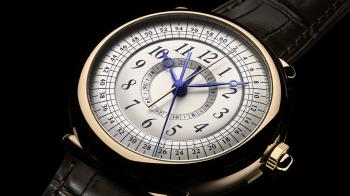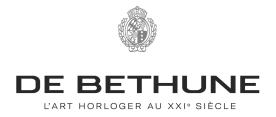The usual requirements for a chronograph are that it should be faster and therefore more accurate. De Bethune, however, chose to take a different tack. Founded in 2002, the young firm headed by watchmaker Denis Flageollet implemented an idea that was far easier to express yet much harder to achieve: developing the first chronograph with all-central hands.
Farewell Bicompax and Tricompax counters
The various roles of each hand are straightforward enough: the two usual Breguet-style open-tipped hours and minutes hands and three others for the chronograph denoting hours, minutes and seconds. With the exception of the minutes indicator, all the hands are made of flame-blued, hand-polished steel.
To enhance readability, De Bethune designed a dial with convex surfaces — an approach typical of the brand’s style. At the center sits the 24-hour hours counter capable of timing durations of up to 23 hours 59 minutes and 599/10 seconds; next comes the minutes counter, followed by the seconds counter at the outer edge.
Since both these last two units of measurement run from 0 to 60, they share the same scale rather than cluttering up the dial with two different ones. The layout nonetheless has all the room it needs, as the case sports a generous 46mm diameter, while still fitting snugly on the wrist thanks to the brand’s hallmark ‘floating’ lugs. The hunter-type caseback reveals the DB29 Maxichrono’s doubly fast tourbillon completing one rotation every 30 seconds and beating at 36,000vph.

Clutch encounters oh the third kind
The ambitions were equally lofty when it came to the movement. Its structure involved a complete redesign of the traditional chronograph clutch mechanism. The latter generally consists of a column wheel, referred to as a ‘vertical’ clutch. Practically speaking, this comprises a large gearwheel with alternating solid and hollow areas servig as a guide for the pivots that come to rest on it, each one controlling one of the chronograph functions (start, stop, reset).
The column wheel principle is the most widely used in watchmaking, not least because it’s simple (hence reliable) and effective. It does however involve a few drawbacks: triggering the pusher is somewhat jerky, and the hands may stutter when the chronograph is started or reset. These shortcomings are remedied in another type of mechanism, known as the ‘horizontal’ or ‘shuttle’ clutch. This version is gentler, yet also more delicate and fragile. Could there be a way to have the best of both worlds?
Having your cake and eating it
De Bethune called its solution the ‘absolute clutch’. Its mechanism makes the most of the advantages of both horizontal and vertical clutches — and overcomes their respective weaknesses. It boasts considerably less of the friction that disrupts traditional movements in both chronograph and normal mode. It took the brand’s R&D seven years to bring the concept to life.
In this system, the seconds counter is controlled by the new absolute clutch, the minutes hand is run by an oscillating pinion and the hours counter is driven via a horizontal clutch. In short, the DB29 features three different types of clutch powering three semi-independent systems controlled by three interdependent column wheels.

Recognition
In 2014 De Bethune’s Maxichrono won the Chronograph award at the Grand Prix d’Horlogerie de Genève competition. Taking delivery of the prize, Pierre Jacques summed up the ethos of the timepiece, which itself embodies the brand’s positioning: “We know we’ll never be a watchmaking powerhouse. But we also know we have the resources to become a creative powerhouse for watchmaking.”
The very first Maxichrono was released in prototype form in 2006 in the DB21 collection, but the first commercial version was the DB29 Maxichrono unveiled in 2014. The DB28 Maxichrono was also released in 2014, followed by the DB21 Maxichrono Réédition (10 pieces produced in 2019 in a revised 44.4mm diameter).
DB29 Maxichrono
CASE: rose gold, sapphire crystal and caseback protected by a cover
DIAMETER: 46mm
MOVEMENT: DB2039, hand-wound, 30mm diameter, 450 components, hand-finished, self-regulating twin barrel (a 2004 innovation by De Bethune), silicon annular balance wheel encircled by a white gold ring (2010 patent), De Bethune hairspring with flat terminal curve (2006 patent), silicon escape wheel, De Bethune ultra-light silicon and titanium 30-second tourbillon (a 2008 innovation by De Bethune), De Bethune absolute clutch (2014 patent), 36,000vph, 5-day power reserve
FUNCTIONS: hours, minutes, monopusher chronograph with 24-hour, 60-minute, and 60-second counters
DIAL: central 24-hour counter, hours chapter ring, minutes ring and counter, outer ring with chronograph seconds markers
STRAP: extra-supple alligator leather
LAUNCH YEAR: 2014
This year GMT Magazine and WorldTempus have embarked on the ambitious project of summarising the chronograph since the year 2000 in The Millennium Watch Book - Chronographs, a big, beautifully laid out coffee table book. This article is an extract. The Millennium Watch Book - Chronographs is available in both French and English here.







